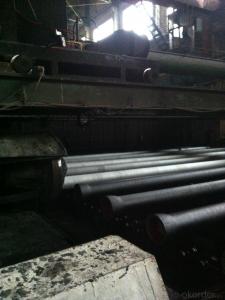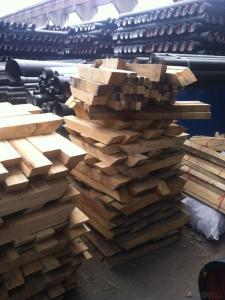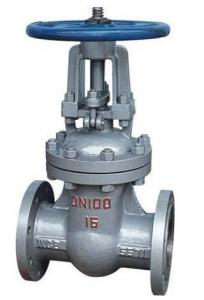DUCTILE IRON PIPES & FITTINGS K9 CLASS DN125
- Loading Port:
- Tianjin
- Payment Terms:
- TT OR LC
- Min Order Qty:
- 20 pc
- Supply Capability:
- 3000 pc/month
OKorder Service Pledge
OKorder Financial Service
You Might Also Like
Specif
· Material : Ductile Cast Iron
· Size Range : DN 80mm to DN 2000mm
· Unit Effective Length : 6m or 5.7m
· Manufacture Standard: ISO 2531:1998/ EN 545:2006/EN 598:2007
· Annual capacity : 200,000 tons
· Coating Exterior: Zinc 130g/m2 according to ISO 8179-1 and bitumen coating 70 microns.
· Cement Interior: Portland Cement/ High Alumina Cement/ Sulphate Resisting Cement Lining according to ISO 4179
· Special requirements on external coating and internal lining can be applied
· We also provide accessories such as SBR/EPDM rubber gaskets, lubricant paste, pipe caps, PE sleeves, etc.
Additional Parts:
Each pipe is strictly inspected according to related standard to ensure permanently high performance.
Easy Installation at site and service free for life
Long Service Lifespan
Quotation will arrive you within 24hours once we get your inquiry.
We guarantee offering you a competitive price.
A copy of original inspection reports of pipes will be offered after shipment.
Photos of loading process will be sent to the customer after shipment effect.
We will follow-up the delivery progress after shipment effect and update to the customer on weekly basis.
- Q:How are ductile iron pipes manufactured?
- Ductile iron pipes are manufactured through a process known as centrifugal casting, which involves the use of a spinning mold. The process begins with the selection and preparation of high-quality ductile iron, which is a type of cast iron that contains small amounts of magnesium to enhance its strength and ductility. First, the ductile iron is melted in a furnace at extremely high temperatures. Once the molten iron reaches the desired temperature, it is poured into a spinning mold. The spinning mold is designed in the shape of a pipe, and it rotates at a high speed to distribute the molten iron evenly along its inner surface. As the mold spins, the molten iron cools and solidifies against the mold walls. This rapid cooling results in a fine-grained structure and enhances the mechanical properties of the pipe, such as its strength and durability. The spinning mold continues to rotate until the pipe has completely solidified, which typically takes a few minutes. After solidification, the pipe is removed from the mold, and excess material, known as the "skin," is removed. The skin is typically removed by machining or grinding to achieve the desired dimensions and surface finish. Next, the pipe undergoes heat treatment to further enhance its mechanical properties and reduce internal stresses. Once the heat treatment is completed, the pipe is thoroughly inspected for any defects or imperfections. This includes visual inspections, non-destructive testing methods, and pressure testing to ensure the pipe meets the required specifications and standards. If any defects are detected, the pipe may be repaired or rejected depending on the severity of the issue. Finally, the pipes are coated with a protective layer to prevent corrosion and enhance their longevity. This coating can be applied through various methods, such as cement mortar lining, epoxy coating, or zinc coating. Overall, the manufacturing process of ductile iron pipes involves melting the iron, centrifugal casting, cooling, skin removal, heat treatment, inspection, and coating. This process ensures the production of high-quality pipes that possess excellent strength, durability, and resistance to corrosion.
- Q:What are the different types of thrust restraints for ductile iron pipe?
- There are several types of thrust restraints used for ductile iron pipe, including thrust blocks, tie rods, and anchor blocks. Thust blocks are concrete structures placed on either side of a bend or fitting to counteract the forces created by water pressure. Tie rods are steel rods that are anchored to the pipe and secured to an external structure, providing additional support against thrust. Anchor blocks are also made of concrete and are installed at regular intervals along the pipeline to prevent movement and absorb thrust forces.
- Q:Can ductile iron pipe be used for mining applications?
- Certainly, mining applications can make effective use of ductile iron pipe. Ductile iron, a type of cast iron, possesses impressive tensile strength, flexibility, and durability, rendering it well-suited for rugged and demanding environments like mining. Its high strength-to-weight ratio allows for easy handling and installation, making it a cost-effective option for mining operations. Not only are ductile iron pipes resistant to corrosion, but they also exhibit excellent mechanical properties, including high impact and fatigue resistance. These properties make them ideal for the transportation of various materials commonly found in mining, such as water, slurries, and abrasive ores. Additionally, ductile iron pipes boast a lengthy lifespan, ensuring reliable performance and minimal maintenance requirements in mining operations. Moreover, ductile iron pipes endure high pressures and maintain their integrity even under extreme conditions, thus qualifying them for underground mining applications. They can handle the rigorous demands of deep mining operations, including the conveyance of water for cooling or dust suppression, as well as the drainage of wastewater or mine dewatering. On the whole, ductile iron pipes provide the necessary strength, resilience, and corrosion resistance required for mining applications. Their versatility, durability, and ease of installation make them a valuable choice for mining operations, guaranteeing efficient and reliable material transport while reducing downtime and maintenance costs.
- Q:How can the ductile iron pipe depress the elbow so as to prevent it from being opened?
- The elbow is the pipe that changes the direction of the pipe. According to the angle, there are 45 degrees and 90 degrees, 180 degrees, three most commonly used, in addition, according to the project needs, including 60 degrees and other non normal angle elbow.
- Q:How are ductile iron pipes protected against root intrusion?
- Ductile iron pipes are protected against root intrusion through the use of protective coatings and barriers. One common method is to apply an external coating, such as a bituminous or epoxy layer, which acts as a deterrent for root penetration. Additionally, root barriers made of high-density polyethylene or other materials can be installed around the pipes to further prevent root intrusion. These measures help to maintain the structural integrity of the pipes and prevent any potential damage caused by root growth.
- Q:What are the different joint restraint systems available for ductile iron pipe?
- Ductile iron pipe offers several options for joint restraint systems. These systems aim to prevent movement and separation at the pipe joints, ensuring a secure and leak-free connection. The commonly used joint restraint systems for ductile iron pipe include the following: 1. Mechanical Joint Restraint: This system involves a joint adapter and a restraining gland. The joint adapter is bolted to the pipe, while the restraining gland is bolted to the adjacent pipe or structure, preventing any movement. 2. Push-on Joint Restraint: This system uses a push-on joint along with a restraining gland that is bolted to the pipe or structure. The gland grips the pipe, providing axial restraint and preventing movement. 3. Flex-Ring Joint Restraint: This system employs a flexible rubber ring installed inside the pipe's bell. The ring expands against the pipe, ensuring a tight and secure connection by providing radial restraint. 4. Harness Joint Restraint: This system includes a harness wrapped around the pipe and connected to a restraining gland. The harness offers both axial and radial restraint, keeping the pipe in place. 5. Grip-Lock Joint Restraint: This system involves a wedge-shaped restraint inserted into the pipe's bell. The wedge expands and locks into place, providing both axial and radial restraint. 6. Restrained Joint System: This system combines mechanical and flexible joint restraints. It typically includes a mechanical joint adapter, a flexible joint restraint, and a restraining gland, offering both axial and radial restraint. Engineers typically specify these joint restraint systems based on factors like pipe diameter, operating pressure, and soil conditions. Each system has its own advantages and limitations, and the selection depends on the specific project needs and constraints.
- Q:Are ductile iron pipes suitable for installation in areas with high soil settlement and consolidation?
- Yes, ductile iron pipes are suitable for installation in areas with high soil settlement and consolidation. Ductile iron pipes have high strength and flexibility, allowing them to withstand ground movements without cracking or breaking. They are also resistant to corrosion, which further enhances their suitability for such environments.
- Q:Why is the sound speed of nodular cast iron lowered after heat treatment?
- After the heat treatment, the microstructure of the material changes, the graphite changes, eliminating the internal stress of molecules, thus slowing down the speed.
- Q:Are ductile iron pipes suitable for oil and gas pipeline applications?
- Yes, ductile iron pipes are suitable for oil and gas pipeline applications. Ductile iron pipes have numerous properties that make them ideal for use in such applications. Firstly, ductile iron pipes have high tensile strength, which allows them to handle the high pressure and stress associated with oil and gas transmission. This ensures that the pipes can withstand the demanding conditions and maintain structural integrity over time. Secondly, ductile iron pipes are highly resistant to corrosion. Oil and gas pipelines are exposed to various corrosive elements, such as water, chemicals, and salts. Ductile iron pipes have a protective lining, typically made of cement mortar or polyethylene, which prevents corrosion and extends the lifespan of the pipes. Additionally, ductile iron pipes have excellent durability and longevity. They have a long service life, typically ranging from 50 to 100 years, depending on the specific conditions and maintenance practices. This makes them a reliable choice for oil and gas pipeline applications, reducing the need for frequent replacements and minimizing downtime. Furthermore, ductile iron pipes have good flexibility, allowing them to withstand ground movement and absorb shocks and vibrations. This flexibility is particularly important in oil and gas pipeline applications, where the pipes need to adapt to changing terrain and environmental conditions. Lastly, ductile iron pipes are cost-effective compared to other materials commonly used in oil and gas pipelines, such as steel. They offer a favorable balance between performance and price, making them a practical choice for both large-scale and small-scale pipeline projects. Overall, the combination of high tensile strength, corrosion resistance, durability, flexibility, and cost-effectiveness makes ductile iron pipes suitable for oil and gas pipeline applications.
- Q:Can ductile iron pipe be used for irrigation pumping stations?
- Yes, ductile iron pipe can be used for irrigation pumping stations. Ductile iron pipe is commonly used in various applications, including irrigation systems, due to its durability and strength. It has high tensile strength and can withstand high pressure and heavy loads, making it suitable for irrigation pumping stations. Additionally, ductile iron pipe is resistant to corrosion, which is beneficial in irrigation systems where water is present. It is also easy to install and maintain, making it a cost-effective choice for irrigation projects.
1. Manufacturer Overview |
|
|---|---|
| Location | |
| Year Established | |
| Annual Output Value | |
| Main Markets | |
| Company Certifications | |
2. Manufacturer Certificates |
|
|---|---|
| a) Certification Name | |
| Range | |
| Reference | |
| Validity Period | |
3. Manufacturer Capability |
|
|---|---|
| a)Trade Capacity | |
| Nearest Port | |
| Export Percentage | |
| No.of Employees in Trade Department | |
| Language Spoken: | |
| b)Factory Information | |
| Factory Size: | |
| No. of Production Lines | |
| Contract Manufacturing | |
| Product Price Range | |
Send your message to us
DUCTILE IRON PIPES & FITTINGS K9 CLASS DN125
- Loading Port:
- Tianjin
- Payment Terms:
- TT OR LC
- Min Order Qty:
- 20 pc
- Supply Capability:
- 3000 pc/month
OKorder Service Pledge
OKorder Financial Service
Similar products
New products
Hot products
Related keywords


























